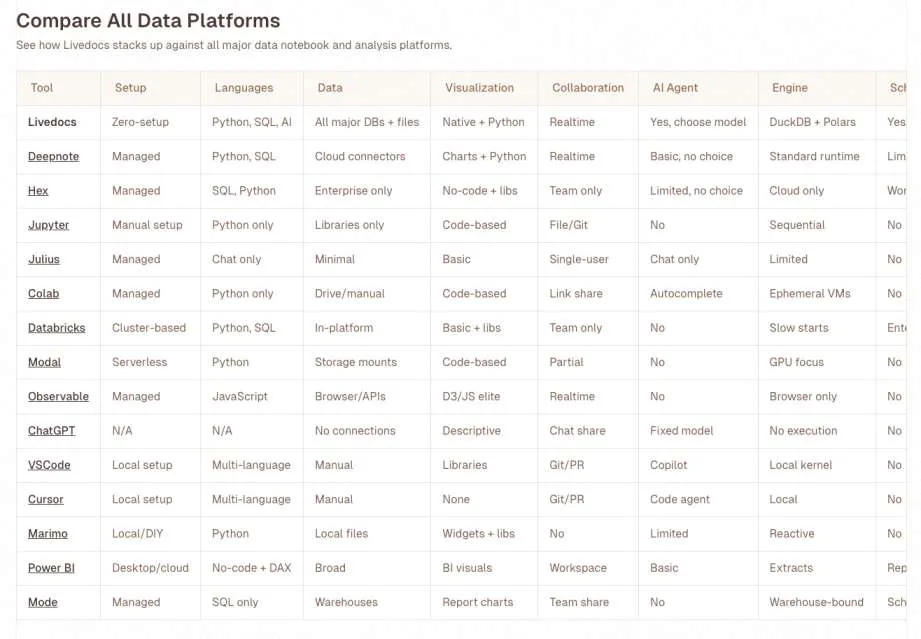How AI Agents Reshaping Data Analytics
The way we work with data is about to fundamentally change. Not in five or ten years, we’re already seeing the shift happening now. AI agents aren’t just a shiny new feature anymore; they’re becoming the actual mechanism through which teams explore, analyze, and act on data.
Here’s what we’re talking about: instead of you manually writing queries, running code, interpreting results, and then asking follow-up questions, an AI agent does much of that iteration for you. You describe what you want to know. The agent generates and executes queries, visualizes results, spots patterns you might have missed, and even suggests next steps. That shift is enormous. And it’s not theoretical. It’s happening right now in teams that have started working with modern AI-augmented data platforms.
The Five-Year Shift: What’s Actually Coming
The landscape is going to look radically different, and there are a few things you can already see coming into focus.
First, the manual grunt work is disappearing.
Right now, analysts spend a huge portion of their time on what you might call the mechanical parts of analysis: writing boilerplate queries, cleaning data, generating standard reports, debugging SQL syntax errors.
That’s all moving toward automation. AI agents will handle the mechanical parts so thoroughly that the people doing analysis work can focus on asking better questions and interpreting what actually matters.
Second, collaboration is becoming human-plus-AI.
In the next five years, the default mode of analysis won’t be “human doing analysis.” It’ll be “human and AI agent working together, with real-time collaboration between team members watching the same process unfold.”
- A product analyst might ask an AI agent to explore user retention patterns.
- An engineer watching that same notebook sees something that could be optimized in the data pipeline.
- A manager sees the finding and immediately asks a follow-up question.
All of that happens in the same space, with the AI handling the execution and humans handling the judgment calls.
Third, the barrier between “data person” and “business person” keeps shrinking.
When AI agents can translate natural language into analysis, non-technical stakeholders can explore data themselves without needing to request reports from analysts. That’s both liberating (analysts do higher-value work) and challenging (data literacy still matters; garbage questions get garbage answers faster).
Fourth, model choice becomes critical.
Right now, many platforms lock you into their specific AI offering, Claude, GPT-4, or whatever else. But in five years, the competitive advantage isn’t going to be about which model you’re using. It’s going to be about flexibility and control. Teams that can swap models, tune them for specific tasks, and adapt as new models emerge will move faster than teams locked into single-provider solutions.
These shifts aren’t coming. They’re already here for teams using modern platforms. The question is whether your tooling is set up to evolve with them.
How AI Agents Actually Change the Game

Let’s get concrete about what this means in practice, because the abstraction only gets you so far.
Right now, if a product team wants to understand why conversion is down, here’s the workflow: someone requests analysis from the data team, waits for availability, gets a report back, asks a follow-up question, waits again for the next report.
Days pass. Context gets lost. People move on to other things.
With an AI agent deeply integrated into your data platform? A product manager describes what they want to understand. An AI agent immediately generates relevant queries, runs them against your data warehouse, creates visualizations, and surfaces what it thinks is important. The PM sees results in minutes, not days.
They can ask follow-up questions in the same interface. An analyst who’s been context-switching between projects can jump in, add expert judgment, and refine the analysis. A data engineer can see the queries the agent is running and immediately spot optimization opportunities. Everyone’s in the same space, the AI handles execution, and humans handle judgment.
That’s not a marginal improvement. It’s a different way of working. The efficiency gains are real. But more importantly, it changes what kind of questions teams ask. When analysis takes days, you ask big, high-stakes questions and hope you get good answers. When analysis takes minutes, you can explore iteratively. You ask a question, see a result, and immediately think of the next thing to check. That exploratory flow is where actual insights emerge.
Why Livedocs Is Built for This Future
Here’s where tool choice actually matters. Most data platforms are retrofitting AI capabilities onto existing architectures. Some don’t have real AI agent support at all. A few are building it in from the ground up, and Livedocs is in that category.
Livedocs treats AI agents as a native feature, not an add-on. That means the agent has proper context about your entire notebook, your data connections, your previous analyses, and your team’s work. It’s not calling an external API that has to rediscover context every time, it’s integrated into your actual environment.
More importantly, Livedocs doesn’t lock you into a single model. You choose which AI model powers your agent. Want to use Claude? OpenAI’s models? Something else entirely? You maintain that flexibility. As new models emerge and better solutions exist for specific tasks, you’re not locked in.
That matters because in an AI-driven future, the tools that win are the ones that let you adapt to rapid change in the model landscape.

Compare that to competitors. Deepnote has AI, but it’s more basic and doesn’t give you real model choice. Hex has autocomplete features and some AI help, but it’s not true agent-driven analysis. Jupyter notebooks by themselves have no integrated AI at all, you’re bolting things together manually. Databricks is powerful, but it’s heavy infrastructure that doesn’t feel native to exploratory analysis. ChatGPT and standalone AI tools don’t have the context of your data or team workflow.
Livedocs occupies a different position entirely: it’s a collaborative notebook platform where AI agents are genuinely first-class, where you maintain model flexibility, and where humans and AI work together naturally within a shared workspace.
Preparing Your Team for AI-Augmented Data Work
If you’re thinking about this transition, here’s what actually matters practically:
-
Start experimenting with AI agents now, even if your current setup doesn’t feel optimized. The learning curve matters, your team needs to develop intuition for how to work with AI agents, how to ask good questions, when to trust agent-generated results, and when to dig deeper. That experience takes time to build.
-
Look for platforms that treat AI as central to the architecture, not peripheral. If AI feels bolted on, it probably will feel clunky to actually use.
-
Prioritize flexibility in model choice. The AI landscape is moving too fast for single-vendor lock-in to be a smart bet.
-
Build collaboration into your evaluation criteria. The future of data work is collaborative and AI-augmented simultaneously. Tools that do both well are worth the investment.
Final Thoughts
The next five years are going to be defined by teams that figure out how to work effectively with AI agents in data analysis. Not teams that have the most advanced AI, but teams that have integrated AI into their actual workflows in ways that make work better.
Livedocs is positioned for this future because it was built with this future in mind. It’s not a traditional notebook platform with AI bolted on. It’s not an enterprise tool trying to layer in agents. It’s a collaborative analysis platform where AI agents are core to how work happens, where model flexibility is built in, and where humans and AI work together naturally.
Try it out yourself 👉 Livedocs.
- 8x speed response
- Ask agent to find datasets for you
- Set system rules for agent
- Collaborate
- And more
Get started with Livedocs and build your first live notebook in minutes.
- 💬 If you have questions or feedback, please email directly at a[at]livedocs[dot]com
- 📣 Take Livedocs for a spin over at livedocs.com/start. Livedocs has a great free plan, with $10 per month of LLM usage on every plan
- 🤝 Say hello to the team on X and LinkedIn
Stay tuned for the next tutorial!

